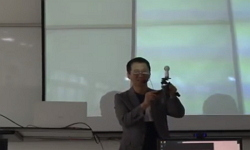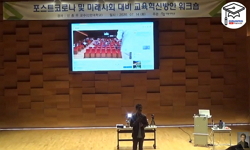본 연구는 코로나 이후 지속될 포스트 펜데믹 시대의 선교 전략으로서 문화선교 방안을 연구하는 것에 목적이 있다. 코로나 시대를 거쳐 위드 코로나 시대, 그리고 언젠가 코로나가 소멸되...
http://chineseinput.net/에서 pinyin(병음)방식으로 중국어를 변환할 수 있습니다.
변환된 중국어를 복사하여 사용하시면 됩니다.
- 中文 을 입력하시려면 zhongwen을 입력하시고 space를누르시면됩니다.
- 北京 을 입력하시려면 beijing을 입력하시고 space를 누르시면 됩니다.
https://www.riss.kr/link?id=A108253317
- 저자
- 발행기관
- 학술지명
- 권호사항
-
발행연도
2022
-
작성언어
Korean
-
주제어
문화선교 ; 포스트 코로나 ; 개인주의 ; 비대면 문화 ; 변두리 문화 ; 미시적 선 ; 인식론 ; 기독교 인식론 ; 기독교 교양교육 ; 신앙주의적 인식론 ; 해석학적 인식론 ; 영성적 인식론 ; Cultural mission ; Post-Corona ; Ncon-face-to-face ; Marginal culture ; Micro-Mission
-
KDC
23
-
자료형태
학술저널
-
수록면
191-219(29쪽)
- 제공처
-
0
상세조회 -
0
다운로드
부가정보
국문 초록 (Abstract)
본 연구는 코로나 이후 지속될 포스트 펜데믹 시대의 선교 전략으로서 문화선교 방안을 연구하는 것에 목적이 있다. 코로나 시대를 거쳐 위드 코로나 시대, 그리고 언젠가 코로나가 소멸되거나 국지화 될 수 있는 포스트 코로나 시대의 문화적 변화가 가지는 복음전도의 장벽을 문화선교를 통해 극복해 보고자 하는 다양한 노력을 위해 문화선교 방안을 위한 기초적 가치를 구축하는 것에 의미가 있다.
이를 위하여 본 연구자는 우선 새로운 문화 흐름을 연구하였다. 코로나를 거치면서 경험하고 강화되었던 비대면 문화와 사회적 거리두기를 통해 몇 가지 문화적 흐름이 형성되고 있음을 강조하였다. 첫째는 인터넷과 유튜브, 그리고 더 나아가 OTT 서비스를 경험하며 형성된 자발적이며 주체적 선택의 문화가 사회의 다양한 영역으로 확대 되고 있음을 밝혔다. 이러한 과정을 통해 자의 반 타의 반 경험하게 된 비대면 문화의 유익은 이를 취하면서 동시에 사회적 욕구를 충족하는 방안으로 선택적 개인주의 문화를 형성하고 있음을 밝혔다. 둘째는 선택적 개인주의 문화는 언제든 자신의 기준과 유익에 따라 대면과 비대면의 사회적 관계 방식을 오갈 수 있는 선택적 비대면 문화를 낳는다는 것을 주장하였다. 셋째는 이로 인하여 가속화되고 극단화 되는 포스트 모더니즘의 양태로서 변두리 문화를 선호하게 될 것을 주장하였다. 이로 인해 나타난 새로운 문화는 획일화 보다는 개별적이며 개인적이고, 불규칙한 기준들을 통해 개인의 이익을 증대하는 문화적 흐름이 강화될 것이다.
이러한 문화 흐름에도 멈출 수 없는 복음전도를 위해 절대적이며 거시적 관점을 담은 기독교 선교의 변화가 필요하며, 그 가교로서 문화선교의 변화가 필요성을 강조하였다. 개별성과 다양성에 기초한 사적영역에 접근하기 위하여 문화선교는 기존의 ‘소개’와 ‘보여줌’이 아닌 ‘선택받음’과 ‘관심받음’의 관점으로 전환되어야 함을 주장하였다. 이를 위하여 정보 제공자가 아닌 수신자의 경험이 상호작용되고 반영된 문화컨텐츠의 구축이 필요함을 밝혔다. 또한 공적영역에서의 사적영역으로 문화선교의 장이 이동하였음을 밝혔다. 사적영역에까지 파고들 수 있는 신뢰구축과 문화컨텐츠 구축은 이러한 변화에 필수적이라 전망하였다.
끝으로 본 연구자는 이를 위하여수신자의 현실적 필요에 응답하는 문화컨텐츠의 구축이 필요하며, 더 나아가 정서적 필요에 대한 응답이 가능한 컨텐츠 구축을 제안하였다. 컨텐츠의 내용 또한 비대면 상호교류에서 대면 상호교류로, 사적 관계로 전환하기 위한 방안들이 필요함을 밝혔다. 이를 통해 세워진 상호 신뢰를 통해 중점적이고 중심적인 복음전도의 내용이 아닌 변두리적 요소로서의 복음전도의 내용으로 구축된 문화컨텐츠와 관계 방식이 필요함을 제안하였다.
지상명령이후 한 번도 멈추지 않은 복음전도가 포스트 코로나 시대에도 지속되기 위해 문화선교의 방향전환이 본 연구를 통해 더욱 전진해 가는데 직간접적으로 기여되길 소망한다.
다국어 초록 (Multilingual Abstract)
The purpose of this study is to study cultural missionary methods as a mission strategy in the post-Corona era. Meaning of this study is to build the fundamental value for cultural missionary works those make overcome the barriers of evangelism come, ...
The purpose of this study is to study cultural missionary methods as a mission strategy in the post-Corona era. Meaning of this study is to build the fundamental value for cultural missionary works those make overcome the barriers of evangelism come, that we passing through Corona era and with-Corona era with cultural missionary methods.
To this end, I first studied a new cultural flow. We emphasized that several cultural flows are being formed through ‘un-contact’ culture and social distancing, which were experienced and strengthened through the corona virus are. First, it was revealed that the culture of voluntary and choices formed by experiencing the Internet, YouTube, and even OTT services, is expanding into various areas of society. It was revealed that the benefits of un-contact culture, which were experienced through this process, are forming a selective individualistic culture as a way to satisfy social needs while taking it. Second, it was argued that the selective individualistic culture produces a selective un-contact culture that can switch between face-to-face and non-face-to-face social relationships at any time according to ones own standards and interests. Third, it was focused that the fringe culture would be preferred as a mode of post-modernism that was accelerated and polarized by this. As a result of the third, the new culture that emerged will strengthen which is cultural flow that increases individual interests through individual, and irregular standards rather than uniformity.
For evangelism that cannot be stopped despite this cultural flow, a change in Christian mission with an absolute and in macro perspective is necessary, and the need for a change in cultural mission is emphasized as a bridge. In order to approach the private realm based on individuality and diversity, it was argued that cultural missionary work should be converted from the perspective of ‘selection’ and ‘interested’ rather than ‘introduction’ and ‘showing’. For this purpose, it was revealed that it is necessary to construct cultural contents that interact and reflect the experiences of the recipients, not the information providers. It also revealed that the field of cultural missionary work has moved from the public realm in to the personal boundary. It was predicted that building trust and cultural content that could penetrate into the private realm would be essential for this change.
Lastly, I needs to construct cultural content that responds to the recipients Felt-Needs, and furthermore, suggests building contents those can respond to emotional needs. The contents also revealed the need for methods to change from non-face-to-face interaction to face-to-face interaction and in to a private relationship. Through the mutual trust established through this, it was suggested that the cultural content and relationship method constructed with the content of evangelism as a marginal element rather than central content of evangelism is needed.
In order for the evangelism that has never stopped after the Great Commission to continue even in the post-corona era. I hoped that this study will directly or indirectly contribute to the change of direction of cultural missionary progress.
목차 (Table of Contents)
- 국문초록
- 1. 서론
- 2. 새로운 문화
- 3. 문화선교 전략
- 4. 결론
- 국문초록
- 1. 서론
- 2. 새로운 문화
- 3. 문화선교 전략
- 4. 결론
- 참고문헌
- ABSTRACT
동일학술지(권/호) 다른 논문
-
- 신학과 실천학회
- 홍종국(Hong, Jong-Kug)
- 2022
-
- 신학과 실천학회
- 최광열(Kwang-ryeol, Choi)
- 2022
-
- 신학과 실천학회
- Kwang-ryeol, Choi(최광열)
- 2022
-
- 신학과 실천학회
- 홍진철(Hong, Jin-Cheul)
- 2022




 DBpia
DBpia






